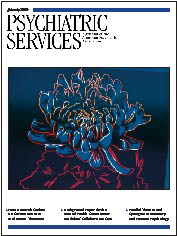Innovations: Emergency Psychiatry: Relative Accuracy of Breath and Serum Alcohol Readings in the Psychiatric Emergency Service
Abstract
Management of changes in physiologic and mental status due to alcohol is a core skill utilized in the psychiatric emergency service. Blood alcohol concentrations are commonly approximated by measuring breath alcohol at triage. However, the blood-breath ratio is highly variable, and breath tests have produced lower readings than blood tests. The authors assessed the accuracy of breath alcohol readings at triage in a medical emergency department compared with subsequent serum alcohol levels taken in the psychiatric emergency service. The mean breath ethanol concentration was significantly lower than the mean corrected serum ethanol concentration (.15±.05 grams per 210 liters and .23±.05 grams per 100 milliliters, respectively). The relative accuracy of breath alcohol tests decreased with increasing serum alcohol. Although its low false-positive rate makes the breath test acceptable for legal purposes, the blood alcohol level is more appropriate for clinical use in emergency settings, because breath tests can underestimate the degree of toxicity.



